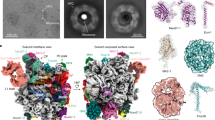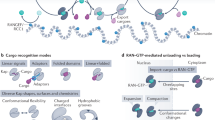Abstract
CRM1 (or exportin 1, Xpo1) transports proteins out of the cell nucleus through the nuclear pore complex. In the cytoplasm, GTP hydrolysis and consequent dissociation of Ran from CRM1 releases low-affinity substrates, while additional factors facilitate release of high-affinity substrates. Here we provide a model for human CRM1 export complex assembly and disassembly through structural and biochemical analyses of CRM1 bound to the substrate snurportin 1 (SNUPN, also called snuportin 1).
This is a preview of subscription content, access via your institution
Access options
Subscribe to this journal
Receive 12 print issues and online access
$189.00 per year
only $15.75 per issue
Buy this article
- Purchase on Springer Link
- Instant access to full article PDF
Prices may be subject to local taxes which are calculated during checkout



Similar content being viewed by others
References
Gorlich, D. & Kutay, U. Annu. Rev. Cell Dev. Biol. 15, 607–660 (1999).
Stade, K., Ford, C.S., Guthrie, C. & Weis, K. Cell 90, 1041–1050 (1997).
Ossareh-Nazari, B., Bachelerie, F. & Dargemont, C. Science 278, 141–144 (1997).
Fukuda, M., Asano, S., Nakamura, T., Adachi, M. & Yoshida, M. Nature 390, 308–311 (1997).
Fornerod, M., Ohno, M., Yoshida, M. & Mattaj, I.W. Cell 90, 1051–1060 (1997).
Dong, X. et al. Nature 458, advance online publication, doi: 10.1038/nature07975 (1 April 2009).
Paraskeva, E. et al. J. Cell Biol. 145, 255–264 (1999).
Petosa, C. et al. Mol. Cell 16, 761–775 (2004).
Askjaer, P., Jensen, T.H., Nilsson, J., Englmeier, L. & Kjems, J. J. Biol. Chem. 273, 33414–33422 (1998).
Matsuura, Y. & Stewart, M. Nature 432, 872–877 (2004).
Engelsma, D., Bernad, R., Calafat, J. & Fornerod, M. EMBO J. 23, 3643–3652 (2004).
Huber, J. et al. EMBO J. 17, 4114–4126 (1998).
Strasser, A., Dickmanns, A., Luhrmann, R. & Ficner, R. EMBO J. 24, 2235–2243 (2005).
Mitrousis, G., Olia, A.S., Walker-Kopp, N. & Cingolani, G. J. Biol. Chem. 283, 7877–7884 (2008).
Ospina, J.K. et al. Mol. Biol. Cell 16, 4660–4671 (2005).
Acknowledgements
We thank Q. Jiang for help with EM map analyses and M. Rosen for critical reading of the manuscript. This work is funded by US National Institutes of Health grants R01GM069909, R01GM069909-03S1 and 5-T32-GM008297, Welch Foundation grant I-1532 and the University of Texas Southwestern Endowed Scholars Program. Use of the Argonne National Laboratory Structural Biology Center beamlines at the Advanced Photon Source was supported by the US Department of Energy, Office of Energy Research, under contract no. W-31-109-ENG-38.
Author information
Authors and Affiliations
Corresponding author
Supplementary information
Supplementary Text and Figures
Supplementary Figures 1–4, Supplementary Discussion and Supplementary Methods (PDF 1583 kb)
Rights and permissions
About this article
Cite this article
Dong, X., Biswas, A. & Chook, Y. Structural basis for assembly and disassembly of the CRM1 nuclear export complex. Nat Struct Mol Biol 16, 558–560 (2009). https://doi.org/10.1038/nsmb.1586
Received:
Accepted:
Published:
Issue Date:
DOI: https://doi.org/10.1038/nsmb.1586
This article is cited by
-
Karyopherin-mediated nucleocytoplasmic transport
Nature Reviews Molecular Cell Biology (2022)
-
Fusion of the CRM1 nuclear export receptor to AF10 causes leukemia and transcriptional activation of HOXA genes
Leukemia (2021)
-
The coming-of-age of nucleocytoplasmic transport in motor neuron disease and neurodegeneration
Cellular and Molecular Life Sciences (2019)
-
A computational approach for nuclear export signals identification using spiking neural P systems
Neural Computing and Applications (2018)
-
XPO1 in B cell hematological malignancies: from recurrent somatic mutations to targeted therapy
Journal of Hematology & Oncology (2017)



